Shaibal S. Mitra (Chair), Paul L’Etoile (Secretary), Robert Emerson, Rachel Farrell, Alan Kneidel, Samuel Miller, and Scott Tsagarakis
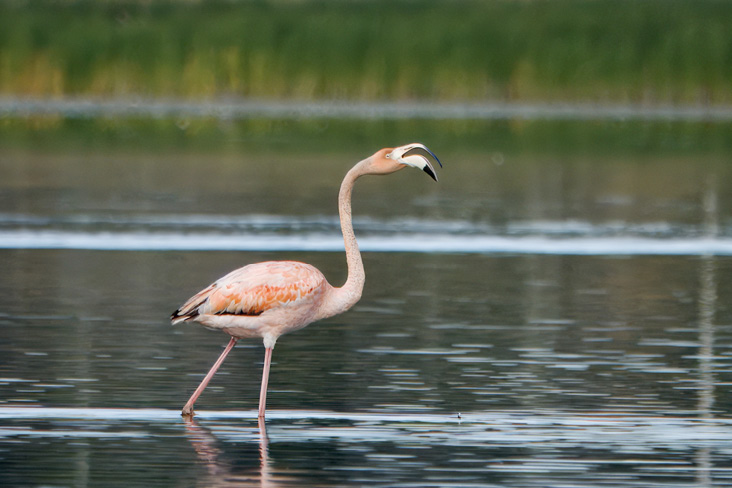
American Flamingo, Briggs Marsh, Little Compton, Newport County, RI; August 11, 2024. Photograph by Peter Modest.
For this report, the Rhode Island Avian Records Committee (RIARC) welcomed two new members, Alan Kneidel and Sam Miller. They take the places of Peter Paton and Doug Wilson, whom we thank for their years of service and expertise. This report presents an evaluation of 61 records. These records were primarily from 2022 but also included two records from 2021, a re-review of a previously accepted record from 2006, and two records from 2024 and 2025 that received expedited review. Highlights include Rhode Island’s first Tundra Bean-Goose and American Flamingo, its first fully documented record of Common Gull (Larus canus canus/heinei), and subspecific resolution of a record of Larus canus kamtschatschensis from 2006 (previously accepted as Mew Gull: RIARC 2006-3, Mitra et al. 2010). Other highlights include the state’s second Gray Kingbird and a historic spring incursion of Arctic Terns.
The records are grouped by species, with each species entry followed by four numbers in parentheses (a, b, c, d), defined as follows:
| a |
the number of records cited by Howe and Sturtevant (1899). |
| b |
the number of records accepted from 1900–2002. This number is derived from Ferren (2024), the Checklist of Rhode Island Birds (Rhode Island Ornithological Club 2002), Conway (1992), and records accepted by a pre-RIARC committee of reviewers for Field Notes of Rhode Island Birds through 2002 (Raithel 2001, 2002). The symbol “++” represents relatively frequent historical occurrence of the species, which could be replaced with a number pending ongoing research. |
| c |
the number of accepted records from 2003–2021, including those published in RIARC’s five previous reports (Mitra et al. 2010, 2021, 2022, 2023, 2024), plus additional records from that period published in the present report. |
| d |
the number of accepted records from 2022—or more recently, in the case of records receiving expedited review—published in the present report. |
The sum of a, b, c, and d represents the total number of verified records in Rhode Island through December 2022.
For each record below, we list the RIARC report number; the vote of the Committee (accept–not accept); the number of individual birds reported; the location; the date(s) of occurrence; and the observer(s), with the following codes: I (initial finder), R (reported details), P (obtained photograph), and A (obtained audio recording).
Ross’s Goose (Anser rossii) (0, 1, 9, 1)
2022–37 (7–0): One; Heaton Orchard Road, Richmond; December 16–17, 2022; Tim Metcalf (I, R, P), Jan St. Jean, Allison O’Connor.
This sighting represents the eleventh accepted record for the state, all but one of which have occurred in the past two decades. The frequency of reports in Rhode Island is still quite low and—given the potential for confusion with Snow Goose and especially with hybrids with that species—the Committee will continue to review reports of Ross’s Goose.
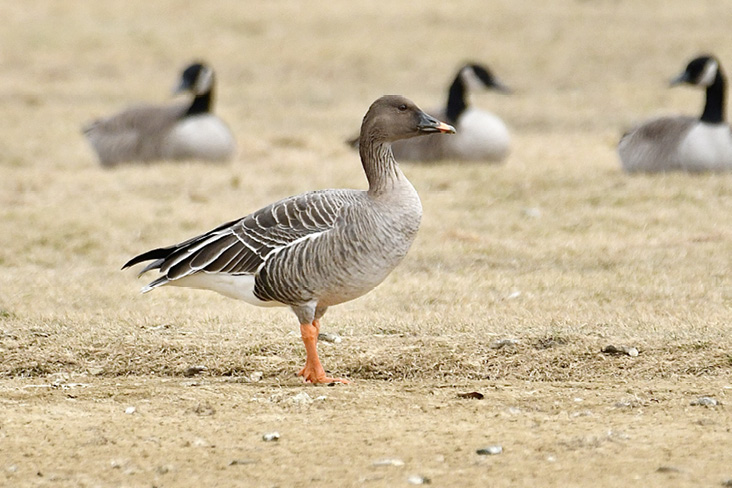
Tundra Bean-Goose, Portsmouth, Newport County, RI; January 18, 2025. Photograph by Sue Palmer.
Tundra Bean-Goose (Anser serrirostris) (0, 0, 0, 1)
2025A–1 (7–0): One; Portsmouth High School fields, Lawton Valley Reservoir et al., Portsmouth; January 18 to March 10, 2025; Joe Koger (I), m.ob.
The first sighting for Rhode Island and New England and one of very few ever recorded in eastern North America, this Tundra Bean-Goose was found by Joe Koger on January 18, 2025. It was observed and studied by many over the next seven weeks.
Until quite recently, tundra-breeding birds of the Bean Goose complex, serrirostris and rossicus, were considered conspecific with taiga-breeding populations (Taiga Bean-Goose A. fabalis: Banks et al. 2007), and previously (e.g., AOU 1983), all of these populations were also considered conspecific with High Arctic–breeding Pink-footed Goose (A. brachyrhynchus). Indeed, Tundra Bean-Goose is in many ways intermediate between Taiga Bean-Goose and Pink-footed Goose—geographically, ecologically, and in appearance. Occurring at the same time as a long-staying Taiga Bean-Goose in Saratoga and Washington counties north of Albany, New York, the Portsmouth bird offered opportunities for comparison for many observers, some of whom carefully noted its shorter neck, shorter and relatively thicker bill, more noticeable angle between bill and forehead, and more restricted orange bill band. In all these ways, it subtly resembled Pink-footed Goose, but it clearly differed from that taxon in terms of the bright orange color of its legs and bill band, its larger and heavier bill, its darker upperwing, and its more extensively black tail.
Tufted Duck (Aythya fuligula) (0, 10, 15, 1)
2022–65 (7–0): One; Trustom Pond National Wildlife Refuge, South Kingstown; January 8–9, 2022; Jan St. Jean (I, R, P), m.ob.
This bird appeared to be a different bird from the adult male reported from Trustom January to March 2021.
American Flamingo (Phoenicopterus ruber) (0, 0, 0, 1)
2024A–1 (7–0): One; Briggs Marsh, Little Compton; July 18 to August 12, 2024; Kate Johnson (I, R, P), m.ob.
One of the more famous birds to visit Rhode Island in recent history (see Providence Journal July 19, 2024), this elegant pink wader was enjoyed by many over the course of its three-week-plus stay in pristine Briggs Marsh. To judge by this bird’s overall appearance and the distinctive pattern of its molting wing coverts, it is almost certainly the same bird that was originally found at Georgica Pond in eastern Suffolk County, Long Island, New York,on May 31, 2024, and present there for most of June except for an apparent sojourn northeast to Chapin Beach, Dennis, on Cape Cod on June 2, and a second appearance there on July 15 just prior to its Rhode Island stay (Mitra 2024).
Eared Grebe (Podiceps nigricollis) (0, 28, 5, 1)
2022–42 (7–0): One; Quonochontaug Beach, Westerly; November 30 to December 5, 2022; Bill Thompson (I, R, P).
The most recently accepted prior report of Eared Grebe also came from Quonnie in December 2019.
Chuck-will’s-widow (Antrostomus carolinensis) (0, ++, 8, 3)
2021–40 (7–0): One; Briggs Beach, Little Compton; May 16–27, 2021; Robert Emerson (I, R, A).
2022–3 (7–0): One; Long and Ell Ponds Natural Area, Hopkinton; April 15, 2022; Mark Pagliarini (I, R).
2022–4 (7–0): One; Tillinghast Pond, West Greenwich; April 30 to June 28, 2022; Barbara Sherman, Cindy Dibble, m.ob.
2022–51 (7–0): One; Succotash Road, South Kingstown; May 23, 2022; Clara Cooper-Mullin (I, R, A).
Although the songs of Antrostomus nightjars can be confused by inexperienced or incautious observers, these reports included either audio recordings or at least careful explanations as to why those caveats may be confidently set aside.
This species is retained for now on the review list because reports are still few enough to warrant close scrutiny. The tendency of this southern species to expand northward and increase in frequency and abundance in Rhode Island is likely being offset by other factors tending to reduce opportunities for nightjars in general, as has been observed for many decades now on nearby Long Island, where Chuck-will’s-widow was first confirmed breeding about 50 years ago but remains rare and local.
Rufous Hummingbird (Selasphorus rufus) (0, 1, 7, 0)
2021–39 (7–0): One; Coventry; December 11, 2021, to January 18, 2022; Eli Mulligan (I), m.ob.
The Coventry bird allowed close scrutiny and excellent photos. Its overall appearance and the patterns and shapes of the rectrices—broader than in Allen’s—supported the identification to species.
Rufous/Allen’s Hummingbird (Selasphorus rufus/sasin) (0, 4, 16, 2)
2022–40 (7–0): One; Charlestown; November 12–15, 2022; David Nelson, Eric Cameron (I, R, P).
2022-68 (7-0): One; Wakefield; November 14 to December 14, 2022; Barbara Chaves (I), Geoff Dennis (R, P).
As is often the case, these individuals could not be identified to species with confidence.
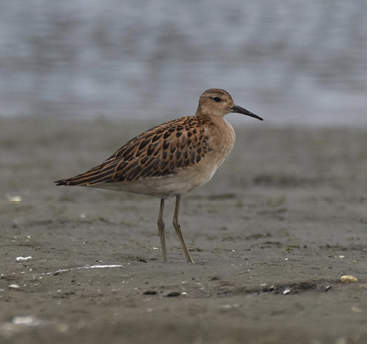
Ruff, Quonochontaug Breachway, Charlestown, Washington County, RI; September 13, 2022. Photograph by Barbara Seith.
Ruff (Calidris pugnax) (0, ++, 9, 2)
2022–43 (7–0): One, male; Arnold Mills Reservoir, Cumberland; August 7–9, 2022; Alan Kneidel (I, R, P); m.ob.
2022–52 (7–0): One, juvenile; Quonochontaug Breachway, Charlestown; September 13–14, 2022; Barbara Seith (I, R, P); m.ob.
Although small, Rhode Island has a long history of hosting Ruffs, dating back to a specimen collected by Newton Dexter at Sakonnet Point on July 3, 1900, and continuing through to the present. The Cumberland record is notable for its inland location in the northernmost part of the state. The Quonnie bird is unusual because juvenile Ruffs have always been exceptionally rare in eastern North America.
Long-billed Dowitcher (Limnodromus scolopaceus) (1, ++, 10, 4)
2022–12 (7–0): One; Succotash Marsh, South Kingstown; April 2 to May 10, 2022; Richard Tucker (I), Patrick Felker (R), m.ob.
2022–13 (7–0): One; Napatree Point, Westerly; September 21, 2022; John Bean (I, R, P), Christopher Veale (P).
2022–14 (7–0): One; Atlantic Avenue, Westerly; November 9–27, 2022; Barbara Seith (I, R, P).
2022–15 (7–0): One; Ninigret Pond flats, Charlestown; September 29, 2022; Paul L’Etoile (I, R, P).
The early spring bird in Succotash Marsh was heard calling and observed at a date when Short-billed Dowitchers would be unusual. The November record from Westerly was photographed in a context appropriate in Rhode Island for this scarce, local, and difficult to identify species. The two September records occurred in contexts where Short-billed Dowitcher is much more numerous, but both were juveniles showing diagnostic plumage features that were nicely photographed.
South Polar Skua (Stercorarius maccormicki) (0, ++, 5, 1)
2022–44 (7–0): One; Cox Ledge; May 22, 2022; Paul L’Etoile (I, R, P).
Although seen only briefly, this bird was photographed. Despite the overall decline in reports of both species of large skuas since the reduction in commercial fishing activity off Rhode Island’s shores, South Polar Skua remains fairly regular offshore from late spring through midsummer.
Thick-billed Murre (Uria lomvia) (4, ++, 9, 3)
2022–45 (7–0): One; Camp Cronin, Narragansett; January 23, 2022; Melissa Alexander (I, R, P), Sam Miller (P).
2022–46 (7–0): One; Sakonnet Point, Little Compton; January 24, 2022; Joel Eckerson (I, R, P).
2022–47 (7–0): One; outside Old Harbor, Block Island; February 21, 2022; Patricia J. Lindsay (I, R), Sam Miller (P), m.ob.
This incursive species made a good showing in Rhode Island in January and February 2022, but it should be noted that it has occurred much less frequently in recent decades than in the early 20th century, when it consistently outnumbered Razorbill (which was much less numerous than at present).
Sabine’s Gull (Xema sabini) (0, 12, 2, 0)
2022–38 (0–7): One; Narragansett Pier, Narragansett; December 24, 2022.
The Committee struggled through two rounds of review with this intriguing report. Two distant images were suggestive of Sabine’s Gull but ultimately deemed not sufficient to rule out the possibility of the much more numerous Black-legged Kittiwake. Sabine’s Gull is very rare even in the period of expected occurrence in September. Especially in late fall and winter, when Black-legged Kittiwake and Little Gull are more frequent and have been proven to cause identification problems, observers should take great care to record critical details of size, structure, and flight style, in addition to details of wing pattern.
Little Gull (Hydrocoloeus minutus) (0, ++, 6, 1)
2022–48 (7–0): One; Block Island Sound two miles south of Point Judith; also Galilee Harbor; December 30, 2022; Todd McLeish (I, R), Barbara Seith (R, P).
Since Rhode Island’s first record at Briggs Marsh in late summer 1946, this Palearctic species has been recorded consistently in a variety of contexts, including the Fields Point sewer outlet in Providence, outer coastal sites, and offshore, as in the case of the current record.
Common Gull (Larus canus) (0, 0, 1, 1)
2006–3 (7–0): One, subspecies kamtschatschensis; Watchemoket Cove, East Providence; January 6 through February 11, 2006; Carlos Pedro (I, P), Shaibal Mitra (R, P), Paul L’Etoile (P), James Smith (P).
2022–2 (7–0): One, subspecies canus/heinei; Narragansett Pier, Narragansett; March 11, 2022; Sam Miller, Alan Kneidel, and Keith Leonard (I, R, P).
The record from Narragansett in 2022 appears to be Rhode Island’s first clearly documented record of Common Gull, Larus canus canus/heinei, as records of “Mew Gull” from 1974 and 1995 were not identified to subspecies. The well-documented record from 2006 had been accepted (Mitra et al. 2010) as “Mew Gull” but was clearly not subspecies brachyrhynchus (now recognized as Short-billed Gull) and was strongly suspected at the time as subspecies kamtschatschensis. The focus of considerable scrutiny since that time (e.g., Ferren 2024), the record was formally re-reviewed here and accepted as “Kamchatka” Common Gull (Larus canus kamtschatschensis).
Nominate canus is the most frequently occurring taxon among “Mew Gulls” in coastal northeastern North America, but both brachyrhynchus Short-billed Gull and kamtschatschensis Common Gull have also been documented in southern New England. In the case of the Narragansett bird, the wingtip pattern and mantle are only subtly darker than RBGU, pointing away from brachyrhynchus; the overall size is similar to RBGU and the mantle only subtly darker than RBGU, pointing away from kamtschatschensis. The East Providence bird from 2006 showed a wingtip pattern matching the Palearctic taxa but was also obviously large and dark, aligning with kamtschatschensis. Because canus and kamtschatschensis are currently regarded as conspecific, these distinct birds are here accepted as the first records of Larus canus for Rhode Island.
Gull-billed Tern (Gelochelidon nilotica) (0, 29, 3, 1)
2022–28 (7–0): One; Ninigret Pond flats, Charlestown; July 11, 2022; Bill Thompson (I, R, P).
Gull-billed Terns, like many tern species, are detected remarkably infrequently even short distances from their breeding areas. The northeasternmost regular breeding sites for this species are along the shores of southwestern Long Island, near Jamaica Bay and Jones Inlet, and the species is rare even at Fire Island and Moriches Inlets, just to the east of these.
Arctic Tern (Sterna paradisaea) (0, 13, 3, 3)
2022–24 (7–0): Seven; Seekonk River, Providence; May 13, 2022; Alan Kneidel (I, R, P).
2022–25 (7–0): 25+; Worden Pond, South Kingstown; May 13–14, 2022; Jan St. Jean (I, R); Tim Metcalf, Christopher Veale (R, P).
2022–26 (7–0): Two; Diamond Hill Reservoir and Arnold Mills Reservoir, Cumberland; May 13, 2022; Peter Capobianco (I, R, P).
The above records were part of an astonishing push of hundreds of Arctic Terns inland over New Jersey, New York State, Connecticut, and Massachusetts on May 13, 2022. Although there are a very small number of precedents for the occurrence of this species as an overland spring migrant in the Northeast—e.g., Griscom’s specimen from Cayuga Lake in central New York State on May 20, 1916—the ordinary mode of occurrence south of breeding areas involves small numbers of nonbreeders along the ocean coast from late May to mid-July (Mitra 2009). The closest thing to a precedent for the events of May 13, 2022, was the group of 16 Arctic Terns observed by Dick Forster at Heard Pond, Wayland, Massachusetts, on May 20, 1979 (Veit and Petersen 1993), although it is possible that such events are underdetected by inland observers historically unfamiliar with the potential for and identification of Arctic Terns. On May 13, members of the Committee, as well as many other active birders, received texts and phone calls from friends reporting unexpected numbers of Common Terns from interior rivers, ponds, and reservoirs, from Maryland to Massachusetts, all of which proved to be Arctic Terns, so it is easy to imagine events such as these being missed when communication was so much different from what it is now.
The Arctic Terns at Worden Pond were accompanied by a Bonaparte’s Gull, itself a rarity on inland ponds in Rhode Island. Griscom’s Arctic Tern specimen from Cayuga Lake was collected on May 20, 1916 (Griscom 1916), in the company of Bonaparte’s Gulls, a Black Tern, and North America’s earliest inland record of Little Gull (Parkes 1953). Note that Griscom did not recognize that the Little Gull he shot was not a Bonaparte’s, nor did L. A. Fuertes, who prepared the specimen (Parkes 1953). Thus, Christopher Veale’s photo-documentation of the Worden Pond Bonaparte’s Gull,and Anthony Vicciarelli’s photos and report documenting the persistence of two Arctic Terns there to May 14 (see https://ebird.org/checklist/S110342957) provide valuable context for this remarkable set of records.
Pacific Loon (Gavia pacifica) (0, ++, 18, 2)
2022-66 (7-0): One; Charlestown Breachway, Charlestown; November 18–19, 2022; Tim Metcalf, Sue Palmer (I, R, P), m.ob.
2022-67 (7-0): One; Quonochontaug Beach and Weekapaug Breachway, Westerly; November 28 to December 13, 2022; Sue Palmer (I, R, P), m.ob.
White-faced Storm-Petrel (Pelagodroma marina) (0, 4, 2, 1)
2022–30 (7–0): One; approximately six miles southwest of Block Island; August 13, 2022; Martin Kaehrle (I, R, P).
Excellent documentation, including description and context as well as photographs, of a remarkably close-to-shore record.
Leach’s Storm-Petrel (Hydrobates leucorhous) (3, ++, 3, 0)
2022–50 (0–6): Two; approximately nine miles southeast of Point Judith; July 22, 2022.
Although the birds were likely correctly identified, this report did not contain sufficient evidence to add to our understanding of the status of this enigmatic species in Rhode Island.
Brown Booby (Sula leucogaster) (0, 3, 5, 1)
2022–29 (7–0): One; Galilee, Narragansett; August 12–23, 2022; Scott Tsagarakis (I), Tim Metcalf (R, P), Sue Palmer, Bill Thompson, Chris Veale, m.ob.
This species’ frequency of occurrence in the Northeast continues to increase.
American White Pelican (Pelecanus erythrorhynchos) (0, 8, 9, 1)
2022–64 (7–0): One; Passeonkquis Cove, Warwick and Quonochontaug Breachway, Charlestown; September 25–30, 2022; Bill Aldrich (I), Barbara Gearhart (R, P), m.ob.
Brown Pelican (Pelecanus occidentalis) (0, 14, 11, 1)
2022–35 (7–0): One; Napatree Point, Westerly; November 5–6, 2022; Bill Thompson (I, R, P).
As was noted in our Fourth Report, Brown Pelicans remain rare in Rhode Island, and this record is the first since two in 2019. As noted there also, the seasonality of Rhode Island differs such that the irregular but sometimes large incursions of this species along the ocean coast of nearby Long Island, New York, have not yet occurred along Rhode Island’s south shore or even off Block Island.
Inclusion on the review list of this highly distinctive species has been debated since the beginnings of RIARC, but experience has shown that inexperienced observers sometimes misidentify distant Northern Gannets, and even other species, as Brown Pelicans. Records are few enough in Rhode Island to warrant continued scrutiny.
White Ibis (Eudocimus albus) (0, 6, 4, 1)
2022–33 (7–0): One; Ninigret Pond flats; October 16, 2022; Bill Thompson (I, R, P).
Although this record is just the eleventh for Rhode Island, this species is expanding rapidly to our south, has been breeding in New Jersey since 2020, and is occurring with increasing frequency in the Northeast.
White-faced Ibis (Plegadis chihi) (0, 2, 12, 3)
2022–5 (7–0): Two; Seapowet Marsh, Tiverton; April 22, 2022; Richard Bradley (I, R), Tim Metcalf (P).
2022–6 (7–0): One; Fort Getty, Jamestown; May 2, 2022; B. J. Whitehouse (I), Tim Metcalf (R, P).
2022–7 (7–0): One; Seapowet Marsh, Tiverton; June 15, 2021; Sam Miller, Joel Eckerson (I, R, P).
This species has been reported annually in recent years.
Golden Eagle (Aquila chrysaetos) (5, ++, 8, 1)
2022–53 (7–0): One; Burlingame State Park, Charlestown; December 18, 2022; Scott Tsagarakis (I), Jessica Bishop (I, R, P), Allison O’Connor (I).
Mississippi Kite (Ictinia mississippiensis) (0, 6, 14, 4)
2022–19 (7–0): Two; Warwick; May 16–18, 2022; Andy Eckerson (I, R, P).
2022–20 (7–0): One; Benson Preserve, North Kingstown; May 18, 2022; Jan St. Jean, Carlos Pedro, Chris Veale, Tim Metcalf (I, R, P).
2022–21 (7–0): One; Dear Run Road, Richmond; May 22, 2022; Erin Metcalf, Tim Metcalf (I, R, P).
2022–22 (7–0): One; Francis Carter Preserve, Charlestown; May 29–30, 2022; Tom Younkin (R, P).|
2022–23 (1-6): One; Block Island; June 4, 2022.
These records reflect the recent and ongoing expansion of this species in the Northeast. The report from Block Island was very possibly correct but lacked sufficient detail to document the record.
Ash-throated Flycatcher (Myiarchus cinerascens) (0, 6, 7, 0)
2022–34 (0–7): One; South Kingstown; October 29, 2022.
Ash-throated Flycatcher has been reported in Rhode Island about annually in recent years and has become an expected vagrant to the Northeast in late fall. Even so, the very similar Great Crested Flycatcher has been proven to occur, albeit very rarely, at that season, and other species of Myiarchus could potentially occur. The current record was based mainly on several good but overexposed images. During review, Committee members independently noted at least five aspects of the bird’s appearance that raised questions regarding the identification. The head looked large with a smoothly rounded crown, lacking Ash-throated Flycatcher’s characteristic angle-naped appearance. The crown and back appeared definitely greenish, whereas green tones are generally absent or very subtle here on Ash-throated Flycatchers in November. The throat looked more deeply colored (especially in view of the obvious over-exposure of the images) and less contrasting with the crown than on Ash-throated Flycatchers in November. The yellow belly looked brighter and more extensive than expected, especially given overexposure. And the pale margins of the tertials appeared broader than expected.
Western Kingbird (Tyrannus verticalis) (0, ++, 9, 2)
2022–31 (7–0): One; Trustom Pond NWR, South Kingstown; September 23, 2022; Sandra Slead, Russ Mungeam (I, R, P).
2022–32 (7–0): One; North Light, Block Island; October 8, 2022; Joel Eckerson, Harrison Hepding, Matthew Eckerson, Sam Miller (I, R, P).
Records are few enough in Rhode Island, and potential for confusion with other species of Tyrannus significant enough, to warrant continued scrutiny.
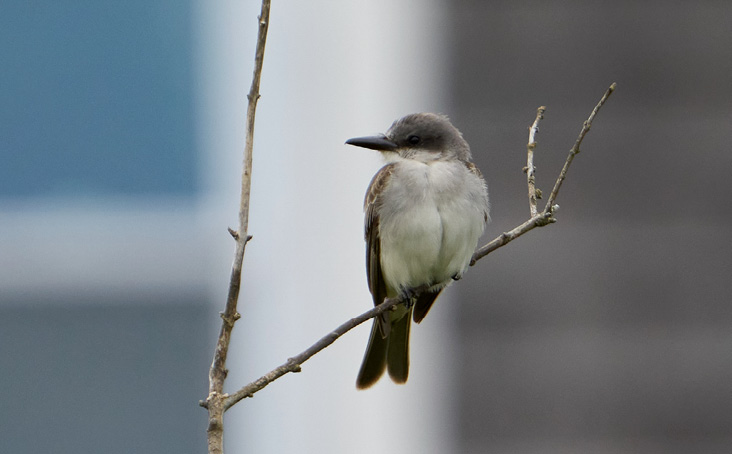
Gray Kingbird, Watch Hill, Westerly, Washington County, RI; November 5, 2022. Photograph by Bill Thompson.
Gray Kingbird (Tyrannus dominicensis) (0, 0, 1, 1)
2022–36 (7–0): One; Watch Hill, Westerly; November 4–6, 2022; Noah Barreto (I, R, P), m.ob.
Rhode Island’s second, this Gray Kingbird followed quickly after the first, which was recorded at Goosewing Beach in 2020.
Scissor-tailed Flycatcher (Tyrannus forficatus) (0, 3, 2, 1)
2022–27 (7–0): One; Francis Carter Preserve, Charlestown; June 2, 2022; Louis Sokolow (I, R, P).
Known from the Northeast for many decades as a very low-density vagrant, Scissor-tailed Flycatcher is notorious for the brevity of its appearances in our region.
Cave Swallow (Petrochelidon fulva) (0, 2, 16, 4)
2022–08 (7–0): One; Camp Cronin, Narragansett; April 14, 2022; Jon Piasecki, Finn Harty, Sam Miller (I, R, P).
2022–09 (7–0): One; Trustom Pond NWR, South Kingstown; April 18, 2022; Bill Thompson (I, R, P).
2022–10 (5–1): Three; Napatree Point, Westerly; November 14, 2022; Eric Cameron, David Nelson (I, R).
2022–11 (7–0): One; Charlestown Breachway, Charlestown; November 17, 2022; Claudia Cooper (I, R, P).
Although spring records are much fewer than fall records in the Northeast, the number has been increasing (New York State’s first record was in spring). Whereas almost all fall records are suspected to pertain to P. f. pallida, the subspecies that breeds in Texas, New Mexico, and northern Mexico, there are now several spring records of the Caribbean form (probably P. f. fulva) from New Jersey to Nova Scotia. At present it is not known to which population(s) Rhode Island’s spring records pertain, nor is it clear to what degree the disparity in frequency between spring and fall is a function of the probability of detection. Fall records generally occur in predictable contexts of weather, date, and local flight dynamics, at a season when very few swallows of other species are present. Cave Swallows might easily be overlooked in April and May, when the abundance and diversity of swallows in our region is much greater. Notably, Bill Thompson, who found the Cave Swallow at Trustom Pond on April 18, 2022, also found one there on May 9, 2020 (Mitra et al. 2023).
Bicknell’s Thrush (Catharus bicknelli) (0, 3, 1, 1)
2022–55 (7–0): One; Kingston, South Kingstown; September 30, 2022; Patrick Felker, Noah Goldthwait (I, R, P).
This banded bird represents Rhode Island’s fifth documented record of Bicknell’s Thrush. All of the records listed here refer to banded birds, dating back to 1991, when D. L. Kraus identified the first of three at his Kingston banding station (Ferren 2024; also the site of the current record), with another from Block Island in 2016.
The bird was originally identified as a Gray-cheeked Thrush before review of photos showed that it looked good for Bicknell’s. Measurements were double-checked, and the bird was convincingly identified by a formula combining wing chord and tail length, which is more discerning than each measurement alone. Even so, both of these measurements fell outside of the ranges of overlap with Gray-cheeked Thrush.
Varied Thrush (Ixoreus naevius) (0, 2, 3, 1)
2022–39 (7–0): One; Kingston, South Kingstown; April 8–13, 2022; Devin Silversmith (I, R, P), m.ob.
This species is one of several western North American vagrants that tend to be detected at feeding stations during the winter. Such overwintering birds are often last seen on dates from late March through mid-April, a relatively under-recognized window for new detections of this species (Mitra 2015), as in the current case.
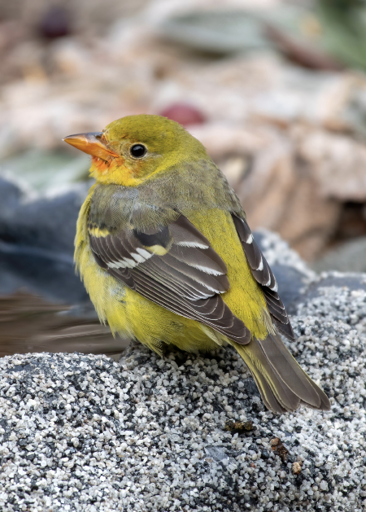
Western Tanager, Touisset Point, Warren, Bristol County, RI; January 18–29, 2022 (here January 22). Photograph by Kathleen Bartels.
Western Tanager (Piranga ludoviciana) (0, 7, 5, 2)
2022–56 (7–0): Two; Avondale Farm, Westerly; January 4–16, 2022; Glenn Williams (I), Christopher Veale (R, P), m.ob.
2022–57 (7–0): One; Touisset Point, Warren; January 18–29, 2022; K. Bartels (I, R, P), m.ob.
One of the two Avondale birds was a continuing bird discovered by Glenn Williams on the Napatree CBC in December 2021, as described in the Committee’s Fifth Report (#2021–35); it was apparently joined by a second bird in early January 2022.
Painted Bunting (Passerina ciris) (1, 8, 6, 0)
2022–58 (7–0): One; Jamestown; January 1–22, 2022; m.ob.
Documentation for the Jamestown bird extended the range of dates for this stunning male originally discovered at a private residence by the homeowner in December 2021 (#2021–36).
CORRIGENDUM
Rhode Island’s first accepted report of Calliope Hummingbird was detailed in RIARC’s Second Report (see Bird Observer 49 (1):29–53). To the surprise of no one in the local birding community, Geoff Dennis (our “Dean of Hummingbirds,” as anointed by Rhode Island’s birding godfather, Dick Ferren) submitted a report (#2013–23) detailing two separate birds visiting the same Little Compton backyard in October 2013. His photographs clearly depicted two separate birds, one of which he dubbed “Cutthroat” in view of some missing gorget feathers. The report was accepted unanimously by the Committee, but the Second Report inadvertently indicated only one bird rather than two. The Committee hereby amends the Second Report to reflect two Calliopes in 2013 rather than one and apologizes for the error.
ACKNOWLEDGMENTS
The Sixth Report of the Rhode Island Avian Records Committee was improved by helpful comments and suggestions from Marshall Iliff and Patricia Lindsay.
LITERATURE CITED
- American Ornithologists’ Union. 1983. Check-List of North American Birds, 6th ed. Lawrence, Kansas: Allen Press.
- Banks, R. C., R. T. Chesser, C. Cicero, J. L. Dunn, A. W. Kratter, I. J. Lovette, P. C. Rasmussen, J. V. Remsen Jr., J. D. Rising, and D. Stotz. 2007. Forty-eighth Supplement to the American Ornithologists’ Union Check-List of North American Birds. Auk 124:1109–1115.
- Conway, R. A. 1992. Field-checklist of Rhode Island birds, 2nd ed. Rhode Island Ornithological Club Bulletin No. 1. Audubon Society of Rhode Island. 57 pp.
- Ferren, R. L. 2024. Birds of Rhode Island: Seasonal Distribution and Ecological History. Ithaca, New York: Cornell University Press. 559 pp.
- Griscom, L. 1916. The Arctic Tern in Central New York. Auk 33:319.
- Howe, R. H. and E. Sturtevant. 1899. The Birds of Rhode Island. Privately printed. 111 pp.
- Mitra, S. S. 2009. Regular inshore occurrence of non-breeding Arctic Terns (Sterna paradisaea) during summer on Long Island, New York. Kingbird 59:2–11.
- Mitra, S. S. 2015. Hudson-Delaware [spring season regional report]. North American Birds 68:325–329.
- Mitra, S. S. 2024. An American Flamingo at Georgica Pond, Suffolk County, New York, 31 May 2024. Kingbird 74:326–329.
- Mitra, S. S., D. Wilson, R. Emerson, R. Farrell, R. Ferren, C. Raithel, and S. Tsagarakis. 2010. First Report of the Rhode Island Avian Records Committee. Bird Observer 38 (5):275–283.
- Mitra, S. S., D. Wilson, R. Emerson, R. Farrell, R. Ferren, P. L’Etoile, P. Paton, C. Raithel, and S. Tsagarakis. 2021. Second Report of the Rhode Island Avian Records Committee. Bird Observer 49 (1):29–53.
- Mitra, S. S., D. Wilson, R. Emerson, R. Farrell, R. Ferren, P. L’Etoile, P. Paton, C. Raithel, and S. Tsagarakis. 2022. Third Report of the Rhode Island Avian Records Committee. Bird Observer 50 (4):251–263.
- Mitra, S. S., D. Wilson, R. Emerson, R. Farrell, R. Ferren, P. L’Etoile, P. Paton, C. Raithel, and S. Tsagarakis. 2023. Fourth Report of the Rhode Island Avian Records Committee. Bird Observer 51 (5):336–345.
- Mitra, S. S., D. Wilson, R. Emerson, R. Farrell, P. L’Etoile, P. Paton, and S. Tsagarakis. 2024. Fifth Report of the Rhode Island Avian Records Committee. Bird Observer 52 (4):251–259.
- Parkes, K. C. 1953. Some bird records of importance from New York. Wilson Bulletin 65:46–47.
- Raithel, C. J. 2001. 1999 Report of the Rhode Island Rare Bird Committee. Field Notes of Rhode Island Birds 382:19–21.
- Raithel, C. J. 2002. Report of the Rare Bird Committee. Field Notes of Rhode Island Birds 396:24–26.
- Rhode Island Ornithological Club. 2002. Checklist of Rhode Island Birds.
- Veit, R. R. and W. R. Petersen. 1993. Birds of Massachusetts. Lincoln, Massachusetts: Massachusetts Audubon Society.
